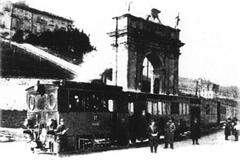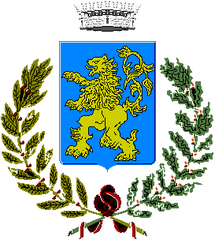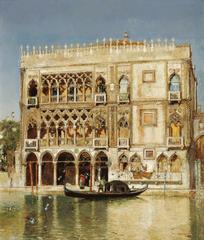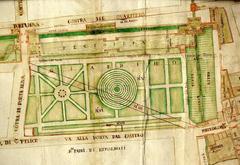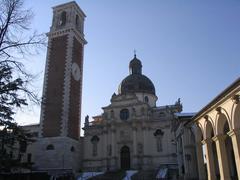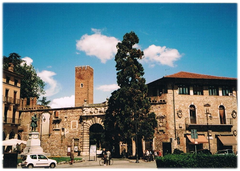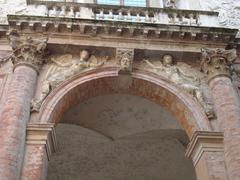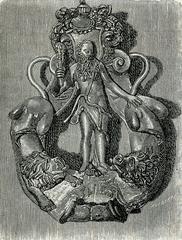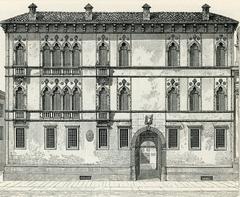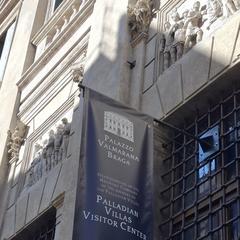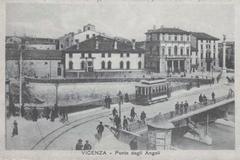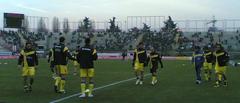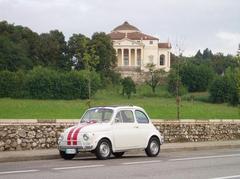
Palazzo Porto Visiting Hours, Tickets, and Vicenza Historical Sites Guide
Date: 03/07/2025
Introduction
Palazzo Porto in Piazza Castello, Vicenza, stands as a prominent example of Renaissance architecture and a testament to the city’s social and cultural evolution. Designed by the renowned Andrea Palladio for the Porto family in the 1570s, the palace embodies both the ambitions of Vicenza’s noble families and the architectural ideals of the Renaissance. Though construction was never completed, the surviving façade, adorned with grand Composite columns and detailed friezes, powerfully conveys Palladio’s vision. As a UNESCO World Heritage Site, Palazzo Porto is an essential landmark for visitors interested in history, art, and architecture.
This guide provides a comprehensive overview, including historical context, architectural features, visiting hours, ticketing, accessibility, travel tips, and information about nearby attractions, ensuring you have all the resources needed to plan a rewarding visit (Italyscapes; VicenzaVillePalladio; UNESCO; Wikipedia).
Historical Background
Origins and Patronage
Commissioned by Alessandro Porto in the early 1570s, Palazzo Porto was intended to reflect the family’s prominent social standing in Vicenza. The Porto family divided inherited properties in Piazza Castello, and Alessandro’s commission of Palladio for the new residence affirmed their status and taste (Italyscapes). The palace’s location and design were carefully chosen to assert the Porto family’s civic presence.
Palladio’s Architectural Vision
Andrea Palladio, whose architectural legacy defines much of Vicenza, designed Palazzo Porto with an ambitious seven-bay façade utilizing giant Composite order columns placed on high plinths. The alternating triangular and rounded window pediments, along with decorative friezes of garlands, exemplify Palladio’s adaptation of classical Roman elements to an urban setting (VicenzaVillePalladio). These features were intended to showcase both cultural sophistication and family prosperity.
Social Context and Rivalries
The construction of Palazzo Porto took place in a climate of intense rivalry among Vicenza’s noble families. The Porto family’s strategic marital and social alliances, such as their connection to the Thiene family, spurred a wave of architectural competition, with each family seeking to outdo the other in grandeur and innovation (Italyscapes).
Construction and Incompletion
Despite the ambitious plans, only two of the intended seven bays were ever constructed. Work slowed and eventually halted by the late 16th century, likely due to financial constraints and shifting political circumstances. The incomplete palace remains attached to the older 15th-century Porto residence, offering a unique window into Renaissance construction practices and the challenges faced by patrons and architects alike (VicenzaVillePalladio).
Restoration and Preservation
Palazzo Porto’s historical and architectural value led to its inclusion in the UNESCO World Heritage Site “City of Vicenza and the Palladian Villas of the Veneto” in 1994. Significant restoration work from 2009 to 2011 stabilized and preserved the building, ensuring it continues to serve as a cultural landmark for future generations (UNESCO).
Architectural Features
- Façade: The palace’s façade is distinguished by its two completed bays, with grand Composite columns on tall bases, alternating window pediments, and an elaborately carved frieze of oak garlands.
- Urban Context: Its placement on Piazza Castello integrates the palace into Vicenza’s historic core, contributing to the visual harmony and civic identity of the square.
- Interior: While the interior is largely inaccessible, surviving spaces reflect Palladio’s emphasis on proportion, light, and the relationship between public and private domains (Wikipedia).
Visiting Palazzo Porto: Practical Information
Location
- Address: Piazza del Castello 18, Vicenza, Italy
- Transport: 450–500 meters from Vicenza railway station; served by city bus lines (1, 2, 4, 5, 7, 10, 18).
- Parking: Limited in the historic center; public transport recommended.
Visiting Hours
- Exterior: Visible at all times from Piazza Castello.
- Interior: Not regularly open to the public. Occasional openings for special events, guided tours, or cultural initiatives. Check current schedules on the official Vicenza tourism website.
Tickets
- Exterior: Free of charge.
- Interior: Fees apply for special openings or private tours; booking in advance is necessary. Palazzo Porto is generally not included in combined tickets like the Vicenza Card.
- Special Events: Watch for cultural events such as “Open Monuments” days or architecture festivals for rare interior access (Vicenzae.org).
Accessibility
- Exterior: Piazza Castello and the palace façade are accessible to all.
- Interior: Some accessibility limitations due to historic structure—contact tour organizers for specific arrangements.
Nearby Attractions
- Palazzo Thiene: Another Palladian masterpiece across the square.
- Basilica Palladiana: Iconic civic building with Palladio’s loggias.
- Teatro Olimpico: The world’s oldest surviving indoor theater.
- Palazzo Barbaran da Porto (Palladio Museum): Exhibition venue dedicated to Palladio’s work.
- Piazza dei Signori: Main square with vibrant cafés and historic buildings (Palladio Museum; Musei Civici Vicenza).
Frequently Asked Questions (FAQ)
Q: When is Palazzo Porto open to the public?
A: The exterior is always accessible. Interior access is limited to special events or guided tours—check the tourism portal for updates.
Q: Are tickets required?
A: No tickets for viewing the exterior. For special interior tours, tickets must be booked in advance.
Q: Is the site accessible to those with disabilities?
A: The square and façade are accessible; interior accessibility varies and should be confirmed beforehand.
Q: Are guided tours available?
A: Yes, during special openings or by arrangement with local cultural organizations. Many walking tours of Vicenza’s Palladian heritage include Palazzo Porto’s exterior.
Q: Can I take photographs?
A: Photography is welcome outside; interior photography is subject to tour organizer guidelines.
Visitor Tips
- Plan Ahead: Due to limited interior access, confirm tour dates and book early.
- Combine Visits: Explore nearby Palladian sites for a deeper understanding of Vicenza’s heritage.
- Best Times: Spring and autumn offer pleasant weather and lighter crowds.
- Download the Audiala App: Enhance your visit with self-guided tours, multimedia content, and up-to-date event information.
Preservation and Legacy
Although unfinished, Palazzo Porto’s monumental design and cultural resonance make it a vital part of Vicenza’s UNESCO-recognized ensemble. The palace’s façade exemplifies Palladian principles and continues to inspire architects and visitors alike. Ongoing preservation ensures that this Renaissance landmark remains a source of pride and educational value for future generations.
Official Resources and Contact
- Tourist Information Office: Piazza Matteotti, 12, Vicenza | Tel. +39 0444 320854 | Vicenzae.org
- Palladio Museum: Palladio Museum Contact
Related Articles
- [Basilica Palladiana: Vicenza’s Iconic Civic Landmark]
- [Exploring Teatro Olimpico: The World’s Oldest Indoor Theater]
- [A Guide to Palladian Villas in Vicenza and Surroundings]
Conclusion and Next Steps
Palazzo Porto in Piazza Castello stands as a vivid reminder of Vicenza’s Renaissance ambitions and Andrea Palladio’s architectural mastery. Its unfinished grandeur narrates both the aspirations and realities of the city’s elite, offering visitors a direct link to the past. Whether you experience the palace’s historic façade, participate in a rare interior tour, or explore Vicenza’s constellation of Palladian sites, Palazzo Porto is an essential destination for anyone passionate about art, architecture, and cultural history.
Plan your visit today, and for the most current information on opening hours, tickets, and special events, consult official tourism resources or download the Audiala app for a personalized experience.


